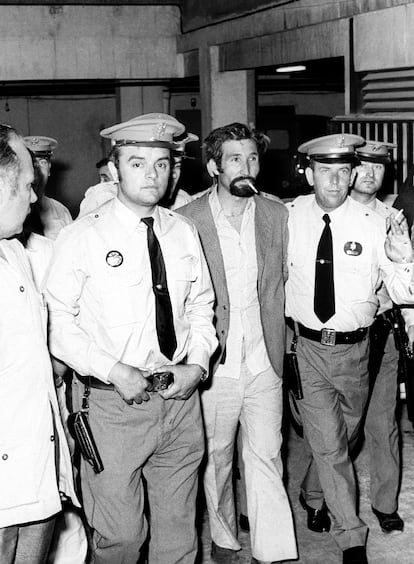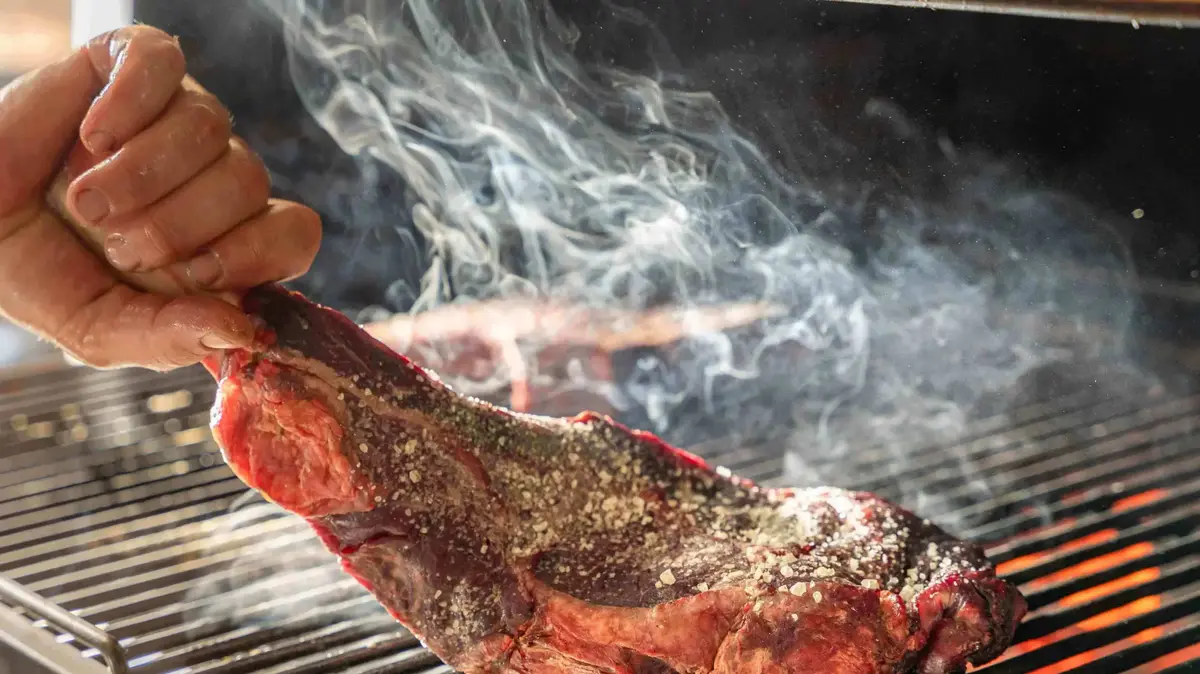A C. Tangana he puts what quinqui.
The artist started his great year of success by propelling himself from that territory.
It was with the video clip
You stopped loving me
, released in November 2020 and the preview of his latest album.
The first bars of the song sounded like
rumbachata
—Particular rhythmic mix of rumba and bachata— and the beehives of Madrid appeared, unique buildings in the Concepción neighborhood reminiscent of the old outskirts of the capital, on the edge of the M-30. With that street scent, a boy and a girl, who seem to be C. Tangana and Rosalía himself when they were a couple, meet on the street. He, with a motorcycle helmet in his hand and a mobile phone in his ear; she, clapping her hands, sat on the back of a wooden bench. A stamp of marked quinqui inspiration and the first appearance of El Madrileño, his alter ego with which he has starred and exploded Spanish music in the last year.
El Madrileño is a tribute to the quinqui universe. Similar to the one that Rosalía — or Rosalía — did when she showed her work in a polygon in Barcelona from inside a truck, in a tracksuit, with sports shoes and full of rings. She also revolutionized the music scene two years ago with
Malamente.
Both contemporary pop icons were born more than a decade after the emergence of the quinqui culture - at the end of the seventies - but they are the most recognizable faces of a legacy with references to marginality, survival or pimp.
Since 2009, the quinqui lives a constant vindication. The exhibition
Quinquis dels 80: cinema, premsa i carrer
(Quinquis of the 80s: cinema, press and street), at the Center for Contemporary Culture of Barcelona (CCCB), marked the first milestone. Later, other artists and creators picked up the baton. For example, the films
Criando ratas
(2016) or
Quinqui Stars
(2018), pioneers of neoquinquismo. Director Daniel Monzón, creator of
Cell 211
or
El Niño,
now joins this cinematographic subgenre
.
His new film,
The Laws of the Border
, the San Sebastián Film Festival closes.
"[Lo quinqui] seems to me to be a space that arouses fear and fascination," says Monzón.
"Talk about everything that society told you you couldn't do, but you wanted to try."
The quinquis of the new film by Daniel Monzón, entitled 'The laws of the border'. QUIM VIVES
Sitting in a editing room in Madrid, the director fervently explains that the quinqui universe talks about “what it is like to live quickly” and does so “with a great poetic charge”. “In the United States, legends were created with western or mafia movies; in Spain it happened with the quinqui cinema ”, points out Monzón.
The laws of the border
, which is based on the homonymous novel by Javier Cercas published in 2012, starts in the suburbs of Barcelona in 1978 and gets into the day-to-day life of the El Zarco gang, a transcript of El Vaquilla (Juan José Moreno Cuenca), a juvenile delinquent of the time as well as a quinqui movie star.
This Spanish cinematographic genre emerged in 1977. That year, José Antonio de la Loma premiered
Perros callejeros
- also inspired by the life of El Vaquilla - starting the phenomenon. Almost at the same time, Eloy de la Iglesia presents
The Hidden Pleasures
, also a pioneer in the treatment of homosexuality in the cinema in Spain, and which points out some characteristic features of the genre (the sex between them). Both filmmakers will become referents of what is quinqui. De la Loma, thanks to works such as
Perros callejeros II, search and capture
(1979),
The last blows of El Torete
(1980),
Perras callejeras
(1985) or
Yo, el Vaquilla
(1985). From the Church with
Navajeros
(1980),
Colegas
(1982),
El pico
(1983),
El pico II
(1984) or
La estanquera de Vallecas
(1987), which formally closes the kinematic phenomenon.
It was a cinema celebrated by the public, but also repudiated by much of the critics: although certain Pasolinian nods were recognized, it was framed in the B series and
exploitation
(cinema that deals with socially controversial or scandalous subjects).
"Many said it was a cinema that smelled of pee," says Monzón.
And that
Quick, Quick
(1981), directed by Carlos Saura, won the Golden Bear at the Berlinale.
El Lute (with a beard), the first quinqui in history, in Seville in 1973, during one of his arrests.
jgv (Efe) / EFE
It is a filmography claimed as a social denunciation, as well as criticized for its moralizing attitude and its lack of political depth. “With all its contradictions, it represents the most disadvantaged; articulates an alternative history to the festive modes of the Movida and to the story of modernity fostered by the so-called culture of the Transition ”, sums up Eduardo Matos-Martín, professor of Comparative Literature at New York University and one of the coordinators of the book
Out of the law. Sieges of the quinqui phenomenon in the Spanish transition
(Comares, 2015). "While the culture of the bourgeoisie [the Movida] rises to a sublime category, that of the poor [lo quinqui] tries to reduce it to sociology or anthropology", it is pointed out in the introduction to the volume: "For this reason, it is necessary to return the view to the past quinqui to understand our present ”. Monzón sums it up like this: "It was the B-side of the Transition."
Quinqui comes from a hardware store, which sells hardware (usually low-quality metal objects). That was El Lute's trade. “A man who was born to be persecuted (…) for being poor”, sang Boney M. Eleuterio Sánchez's life began in a shack in 1942. Like most of the ironmongers, he was a merchero, a nomadic community half-horse among the gypsies and the payos; that is, racialized people. At the age of 22, El Lute is arrested and convicted, accused of a murder that he did not commit. The penalty is death, but it is commuted to life imprisonment. His legend begins after starring in two famous escapes from Franco's prisons, in 1966 and 1970. His figure was increased by the press of the time, scrutinized by Franco's censorship and addicted to events,who redefined the term quinqui and associated it with a racialized thug.
Juicy Bae, in an image from the book Making FluS, about the origins of trap.Alba Rupérez (El Bloque)
The cinematographic genre was released in 1977, only two years after the death of the dictator and with whiter protagonists than the original quinquis. At that moment, the imaginary expands to define an emerging urban culture, young, peripheral, marginal and whose influence survives. "There are cultural prejudices with respect to quinqui, but it has generated identity signs that last generational," sums up Mery Cuesta, art historian and curator, along with Amanda Cuesta, of the
Quinquis de los 80
exhibition
. She is a professor at Pompeu Fabra University. He teaches Art in the Audiovisual Communication career. His students are in their twenties. "Every year they make me work on what quinqui or ask me about
Navajeros
", Explain.
"It never ceases to fascinate because it appeals to the freedom to be young and do whatever you want."
The director Daniel Monzón (second from the right), with the members of the musical group Derby Motoreta's Burrito Kachimba in an industrial warehouse in Seville.
GIANFRANCO TRIPODO
Members of Derby Motoreta's Burrito Kachimba could be Cuesta's students. This young Sevillian band is in charge of putting music to the film
The Laws of the Border
. Daniel Monzón did not hesitate for a second to sign them after hearing their first and only album until then —this spring they released the second,
Hilo negro
. A sound "stew" that refers to Triana, Smash or Medina Azahara with hard rock and psychedelia under a badass and neighborhood aesthetic and that they named as
kinkidelia
. "It is music to vent, but, above all, it is a street proposal with a lot of attitude," explains Miguel García,
Piranha
, singer of the group. His first video clip,
The Gypsy Jump
, used excerpts from the film
Navajeros.
"We are the gang of drug robbers," adds guitarist Scott Gringo with a smile.
"Our songs are meant to be played with colleagues in the park," he adds.
The singer and producer of trap and reggaeton Yung Beef (Granada, 1992) in an image of the publication 'Making Flu $'. Alba Rupérez (El Bloque)
The street, the park, the open space are referential spaces of the original quinquis.
It is your space.
They are the children of the rural exodus, the
lower-class
baby boomers
, who grew up in newly built neighborhoods on the outskirts of major cities.
That is how Otxarkoaga was born in Bilbao, San Blas in Madrid, La Mina in Barcelona… Because quinqui is not understood without precariousness.
In the Spain of the late 1970s, the political news was good: the dictator had died and democracy was on the horizon. But the economy was not keeping up: after years of growth, since 1960, the 1973 oil crisis caused a global halt that also affected Spain. The unemployment rate quadrupled between 1975 and 1980, dramatically affecting those under 25 years of age. A problem for the kids who grew up in the new peripheries. This is how it happened in the past ... and this is how it is now. Today, the numbers are appalling: youth unemployment exceeds 35% (compared to a general rate of 14.3%, according to data from July 2021). It is one of the largest in Europe. With no hint of opportunities to develop, young people live in a precarious condition that connects with the idiosyncrasy of the quinqui world.
Three young people pose in the publication 'Making Flu $'. Alba Rupérez (El Bloque)
“The democratization of music in Spain through the Internet allowed people who did not have resources to dedicate themselves to music with very little from home.
These people had a very close bond with the street, ”explains Daniel Madjody, co-founder of El Bloque, the cultural group that has best explained urban music in Barcelona and that this year has published the choral essay
Making Flu $.
10 years of the new music scene
(Plaza & Janés, 2021), which deciphers the evolution of the Spanish trap scene. For Madjody —who works as a primary school teacher at the Institut Escola La Mina, one of the most impoverished neighborhoods in the Catalan capital and the epicenter of quinquismo in Spain—, trap is related to the lowest social strata. Madjody was one of the first to interview C. Tangana before his success or references such as Cecilio G or La Zowi.
"Today's youth do not perceive themselves very differently from those of the eighties," Mery Cuesta remarks. “They are young people who absorb values and lifestyles typical of the stereotype of the outskirts of big cities, such as the glorification of parties and weekend leisure; desire for money, fame or luxury; the low cultural level; violent modes of expression; or the dedication to drug experimentation ”, he adds. Cuesta is also the author of the essay
Chándal, oro y mantilla. Rosalía's connections with the quinqui universe and the myth of suburban youth
, in the book
La Rosalía. Essays on good love
(Errata Naturae), and affirms that the Catalan "embodies a third wave of quinquismo with an almost purely aesthetic look".
The first was "the origin" in the late eighties.
It followed “the transmutation, in the nineties, to the polygon world, of parking lots and raves”: “The quillo, the cani or the choni are heirs of the quinqui”, affirms Cuesta.
From left to right, the actors Xavi Martín, ChechuSalgado, Marcos Ruizy Begoña Vargas, in a scene from Lasleyes de la frontera.
The social anthropologist Iñaki Domínguez, author of the book
Intersecular Macarras.
A history of Madrid through its street myths
(Melusina) explains that "the culture of nostalgia" is also operating in this third wave of the quinqui esthetician. “Before, what was quinqui was shabby or cañí, now young people appropriate those identities with the idea of consuming them. It is more of a game, an ironic and kitsch form of consumption that is now considered cool ”. Domínguez assures that for the referents Rosalía or C. Tangana being quinqui consists "in living an authenticity sanitized and devoid of danger". "It is something typical of postmodernism that seeks to manipulate and transform representation rather than live the experience." Despite this, the phenomenon stands out for its vindication for the popular and the folkloric.
Daniel Madjody also talks about those links on the musical plane and defines gypsy culture as the germ of trap: “They have been great promoters of urban music”.
A sound that already sounded in groups like Los Chichos, Burning, Eskorbuto or Los Chunguitos.
The latter, authors of
I stay with you
, the main theme of the film
Deprisa, quickly
(1981) and that Rosalía covered at the 2019 Goya gala.
On the left, José Antonio Valdeomar and Berta Socuéllamos in 'Deprisa, Deprisa'.
On the right, C Tangana in one of his concerts.
The intersection between crime and culture can be aesthetic or it can be vital.
In the cinema, the quinqui is distilled in films such as
Barrio
(1998), by Fernando León de Aranoa, which narrates the lives of the children of the quinquis;
Days of football
(2003), by David Serrano, delves into the lives of those who lived through the period years later; in
7 virgins
(2005), by Alberto Rodríguez Librero; in
Yo soy la Juani
(2006), by Bigas Luna, or, more recently, in
Quinqui Stars
(2018), by Juan Vicente Córdoba. To which is now added
The Laws of the Border
, by Daniel Monzón. “What is quinqui is culture. Therefore, the perspective from the outside, with a fascinated look, is important. Talking about that is talking about today, ”sums up Monzón.
That gaze alien to the quinqui world, but attracted to it, is the one that has expanded this universe from the suburbs.
Many attribute that fascination to the deep class identity it exudes despite its apparent depoliticization.
"It is a space that gives a freedom that at the same time allows breaking class prejudices", says Mery Cuesta.
"It is a social reality that has been captured, has transcended and has articulated a narrative," he adds.
"The problem has been that until now there has been a lot of prejudice to recognize a sociocultural value."









